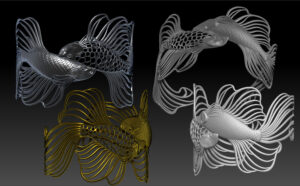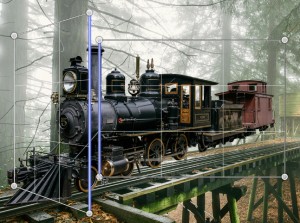Adobe’s new year updates for Creative Cloud design apps includes 3D printing as well as OpenCL support, added 3D tools in Photoshop, seamless Typekit access and more.
Adobe has been updating the Creative Cloud products throughout the year and the company has seen steady growth in its subscription numbers. With the start of the new year, the company is announcing new features for its imaging, illustration, and publication tools. The big noise maker in this announcement is 3D printing, but there are several other significant features in this latest update to Creative Cloud.
3D printing, really?

In a somewhat routine announcement of new features for Creative Cloud, Adobe tossed in its surprise grenade that Photoshop now has a print button for 3D models. The back story on this is that Photoshop’s lead scientist Pete Galt and product manager Zorana Gee visited universities in the UK where students were experimenting with 3D printing. They got an earful on the difficulty of actually printing 3D models without a costly trial and error process. And thus was born the idea of a 3D print button for Photoshop. Adobe has been adding 3D features steadily to Photoshop and the program is 3D-literate in interesting ways, but obviously, Adobe has taken a pretty big step here with its support for 3D printing.
To say, Photoshop has a print button is an oversimplification. Photoshop accepts OBJ, STL 3DS, Collada, and KMZ files, it can analyze the model and optimizes it for 3D printing by repairing the mesh to close holes and ensure it is water tight, it also scales the model to the printer’s requirements. While Photoshop’s print feature is primarily designed for ease of use and to reduce the amount of interaction needed from the user, it does allow people to inspect the model after corrections have been made and allows adjustments to the model after corrections. Users can tweak the resolution, which can impact the correction algorithm, and they can adjust the parameters in the printer profile to optimize and customize the correction. When, ready for print, the Photoshop program can even control the printer telling it to heat up, offers material choices, and provides an estimated print time. It also offers the option of automatically building scaffolds to support the model during printing.
Adobe says they have developed 3PP, an XML format to act as an intermediary between the 3D models and the printers, which provides a uniform approach that describes features of different printers. This information includes area and volume sizes, different methods of filament handling, memory sizes and other features. With this information, Photoshop can optimize the model for print. Adobe offers more information about 3PP with their online Photoshop information.
On rollout, the 3D printing capabilities will support four printers directly: the 3D Systems Cube, Makerbot’s Replicator 2 and Replicator 2X, and the ZCorp Full Color printer. In addition, the 3D print capability will support the Shapeways marketplace allowing models to be sent to the online site and printed. A dialog box provides access to Shapeways’ printers and materials.
To see how all this actually works out, Adobe offers a blog on its 3D printing capabilities.

Oh yeah, other stuff
As cool as the 3D print button in Photoshop is, Adobe is also rolling out several other new features for design and publication. As mentioned, Adobe is paying considerable attention Photoshop’s 3D capabilities. The new Perspective Warp feature is an example of what happens when a company dedicated from its inception to 2D art starts thinking about 3D. Adobe, if you’ll excuse me, takes a different perspective and Perspective Warp tool gives artists the ability to settle a 3D model comfortably into a 3D plane. The tool provides guides along the 3D planes that can then be adjusted to match a 2D image.

It really hasn’t been spelled out too clearly, but Adobe is now using OpenCL for Adobe’s Mercury Graphics Engine which takes advantage of the GPU to speed hardware acceleration. The first tools were introduced on Nvidia’s Cuda but Adobe would obviously prefer an open source option that gives it access to more GPUs. Adobe’s adoption of OpenCL means that GPUs from Nvidia and AMD can speed up processes such as Smart Sharpen, Liquify, and Puppet Warp. Adobe Premiere and AfterEffects are also taking heavy advantage of OpenCL.
Some solid housekeeping features have been added including the ability to link Smart Objects throughout a project so that when an element such as a logo or common image has been updated it will update everywhere the linked object has been used. This will strengthen the ability of team members to collaborate as well as manage a project’s look.
Illustrator has gotten updates that improves control over curves and adds better control point tools.
But, the feature that made me cry is the improvement to Adobe’s Typekit font service. Last year the company introduced Typekit for desktops giving Creative Cloud customers access to Adobe’s huge bank of fonts (over 35K as December 2013). The problem was that you had to stop what you’re doing go find the font, add it, update your library and go back to work. The obvious question is why? Why, if I’m paying this monthly fee and I have legal access to all these fonts, why can’t I just have them when I need them? With this latest release, Adobe allows access to fonts within Illustrator, InDesign, and even Acrobat. Now here’s where the crying starts. When opening an InDesign file from someone instead of being confronted with a daunting list of missing font files, I can just tell InDesign to go get the fonts and stop whining.
These are the highlights. There are plenty more features in this latest update. What Adobe really wants you to know is that it is not stopping and customers are falling into line for its subscription model – most of them at least. Adobe closed out 2013 with more than 1.4 million Creative Cloud members, an increase of more than 400 thousand over the third quarter of 2013 and a number that that beats Adobe’s purposefully cautious predictions for Creative Cloud adoptions. For the laggards, Adobe is resetting its 30-day trials so that people who tried the Creative Cloud and didn’t pull the trigger can have another chance to play with these new tools.





